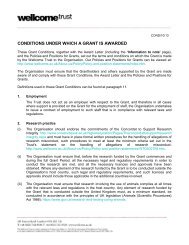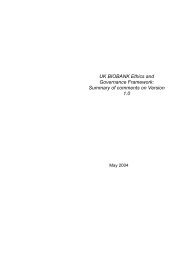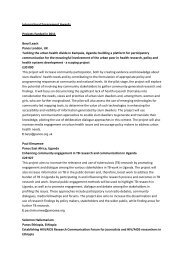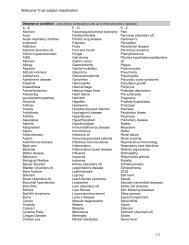Issue 24 - Wellcome Trust
Issue 24 - Wellcome Trust
Issue 24 - Wellcome Trust
You also want an ePaper? Increase the reach of your titles
YUMPU automatically turns print PDFs into web optimized ePapers that Google loves.
WORK IN PROGRESS<br />
Rhodri Hayward<br />
Psychiatry and primary care<br />
in 20th-century Britain<br />
Since World War II, mental health issues have begun to assume a<br />
dominant position within the general practitioner’s caseload. As the<br />
World Health Organization noted in 2001, the number of consultations<br />
in primary care for mental disorders is second only to respiratory<br />
infections. Patients look to their family physicians not simply for the relief<br />
of physical suffering but for psychotherapeutic and pharmaceutical<br />
solutions to the psychological complexities of contemporary life.<br />
This shift from the healing of physical illness to ministering to mental<br />
distress represents a profound transformation in our experience and<br />
expectations of primary care. Current ideas of the doctor’s role have<br />
much in common with those of the 18th century. Nonetheless, it is facile<br />
to equate our contemporary medical expectations with the hopes and<br />
anxieties that patients brought to their doctors 200 years ago. We live<br />
in an era in which psychological and psychiatric categories provide the<br />
fundamental vocabulary through which people make sense of their place<br />
in the world. Commonplace feelings of anxiety or sadness are now often<br />
pathologized as unacceptable signs of psychological ill health.There is a<br />
widespread equation of mental health with personal happiness rather<br />
than the old Victorian ideal of self-control.These days we expect our<br />
general practitioners to guarantee us lives of fulfilment and joy. Such<br />
hopes can lead to deep disappointments for both doctors and patients.<br />
Tracing the relationship between psychiatry and general practice in<br />
20th-century Britain is a complex task. For this reason I have chosen to<br />
concentrate on four discrete topics, each of which encapsulates a distinct<br />
and important aspect of their general history.These are: the impact<br />
of psychological theories on the doctor’s understanding of patient<br />
testimony in the inter-war period; the psychologization of the doctorpatient<br />
relationship during and after World War II; the role of general<br />
practitioner research in the development of psychiatric epidemiology<br />
during the early years of the NHS; and finally, the importance of GPs<br />
as frontline psychiatrists and prescribers of antidepressants.<br />
Effects of World War II<br />
Many doctors became committed to psychological models of the patient<br />
in the years immediately following World War I. Radicalized by their<br />
experiences working with shellshock victims and pensions administration,<br />
practitioners began to recognize the need for a psychological interrogation<br />
of patient testimony. Rival schools of psychodynamic and psychiatric<br />
practitioners developed new approaches to patient testimony which<br />
interpreted the individual’s ‘bodily complaint’ through reference to<br />
personal history, economic motivations and emotional health.These<br />
groups included the Freudians gathered around David Forsyth and Millais<br />
Culpin; the Adlerians led by elite physicians such as Walter Langdon<br />
Brown and Francis Crookshank of the Medical Society for Individual<br />
Psychology; and professional psychiatrists such R D Gillespie at Guy’s and<br />
Aubrey Lewis at the Maudsley. All argued for the reform of medical<br />
education, urging the incorporation of psychological training within the<br />
medical curriculum.Their insistence on the connection of bodily<br />
symptoms to the patient’s situation and emotional history was rooted in<br />
wider political and scientific changes. At one level, as Christopher<br />
Lawrence has noted, the new attention paid to individual factors in<br />
Aubrey Lewis helped develop British social medicine after the war, promoting new attention to the<br />
domestic and environmental context of the patient.<br />
medicine could be seen as part of a patrician reaction to the routinization<br />
of modern medical diagnosis. However, these interpretative connections<br />
also reflected contemporary developments in neurology and<br />
psychophysiology, where new models of the conditioned response, the<br />
stress reaction and the body schema had further emphasized the<br />
complexity of individual diagnosis.<br />
World War II and after<br />
World War II saw the expansion of psychology’s role in general practice.<br />
It moved from being an aid to diagnosis to become the basis for a GPcentred<br />
psychotherapy.The work of physicians such as Arthur Watts of<br />
Ibstock provided a model of the therapeutic encounter which was<br />
popularized through discussions in the Practitioner magazine and later<br />
formalized in the Tavistock seminars led by Michael Balint. Belief in the<br />
efficacy of GP-centred psychotherapy was predicated upon a psychosomatic<br />
model of illness which had developed in the physiological investigations of<br />
W B Cannon, Hans Selye, and Franz Alexander. It was also supported by<br />
the wartime development of British social medicine and social psychiatry<br />
(in the work of John Ryle and Aubrey Lewis, for example) which promoted<br />
new attention to the domestic and environmental context of the patient.<br />
These theoretical developments provided an invaluable resource for GPs<br />
renegotiating their medical roles and professional authority within the<br />
emergent NHS.They suggested that the family doctor retained key insights<br />
into individual cases of mental and psychosomatic illness by virtue of his or<br />
her knowledge of the patient’s personal circumstances and history. I aim to<br />
analyse the relationship between the psychotherapeutic model of the<br />
patient and changes in the professional organization and identity of<br />
general practice.<br />
The growth of primary-care psychotherapy was accompanied by related<br />
developments in general practice research. In the late 1930s, James Halliday<br />
began studies of the incidence of psychoneuroses among Scottish National<br />
Insurance claimants. Halliday’s aim was to underline the necessity of the<br />
4<br />
<strong>Wellcome</strong> History <strong>Issue</strong> <strong>24</strong> October 2003

















